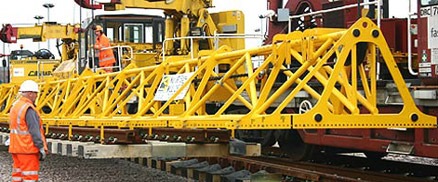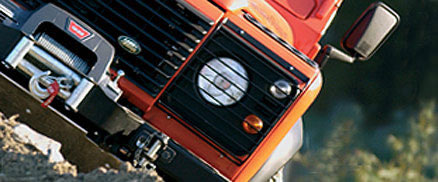July 28th, 2010
Lifting beams may incorporate various loose and detachable items of lifting gear. You should not use defective or distorted beams or attachments. Lifting beams are generally designed for a specific purpose and should not be used for other purposes without consulting the supplier. This will include the size of crane hook from which they are suspended. On no account should lifting beams be suspended from unsuitable size hooks. The weight of the beam, together with its attachments, must be added to the weight of the load when calculating the total load that will be imposed on the crane hook. Ensure that the SWL on the individual lift points is not exceeded. Extra care is needed where these are adjustable. Ensure the load is stable and that the beam remains at its intended attitude during use. Particular care is needed when lifting and setting down as not only may the load become unstable but individual lift points may become overloaded. Use tag lines to control long loads. Do not allow the beam to foul the underside of the crane, or any other obstructions, when raising or transporting loads.
ALWAYS
- Store and handle lifting beams correctly
- Refer to the safe use instructions for slings and attachments used with the beam
- Include the self weight of the beam and attachments when calculating the load imposed on the crane hook
- Ensure the load will remain stable when lifted.
- Ensure that no one lifting point becomes overloaded by the slinging or handling methods
- Use tag lines to control long loads
Never
- Use lifting beams to handle loads other than those for which they are designed
- Fit lifting beams to a hook other than those for which they are designed
- Use damaged or distorted lifting beams and attachments
- Unevenly load lifting beams
- Allow lifting beams to alter attitude during use
- Allow lifting beams to foul the underside of the crane or any obstructions in the area.
Posted in Arbil Rail |
July 28th, 2010
When using slings you should be familiar with the safe use of slings. Slings should only be used by trained operatives who understand the methods of rating and application of mode factors:
<!– /* Font Definitions */ @font-face {font-family:”MS Mincho”; panose-1:2 2 6 9 4 2 5 8 3 4; mso-font-alt:”MS 明朝”; mso-font-charset:128; mso-generic-font-family:modern; mso-font-pitch:fixed; mso-font-signature:-1610612033 1757936891 16 0 131231 0;} @font-face {font-family:”\@MS Mincho”; panose-1:2 2 6 9 4 2 5 8 3 4; mso-font-charset:128; mso-generic-font-family:modern; mso-font-pitch:fixed; mso-font-signature:-1610612033 1757936891 16 0 131231 0;} /* Style Definitions */ p.MsoNormal, li.MsoNormal, div.MsoNormal {mso-style-parent:”"; margin:0cm; margin-bottom:.0001pt; mso-pagination:widow-orphan; font-size:12.0pt; font-family:”Times New Roman”; mso-fareast-font-family:”MS Mincho”;} @page Section1 {size:595.3pt 841.9pt; margin:72.0pt 90.0pt 72.0pt 90.0pt; mso-header-margin:35.4pt; mso-footer-margin:35.4pt; mso-paper-source:0;} div.Section1 {page:Section1;} –>
- Good slinging practice must ensure that the load is as safe and secure in the air as it was on the ground and that no harm is done to the load, lifting equipment, other property or persons.
- Establish the weight of the load, ensure the lifting method is suitable and inspect the sling and attachments for obvious defects. Prepare the landing area making sure the floor is strong enough to take the load. Follow any specific instructions from the supplier.
- Ensure the lifting point is over the centre of gravity. Any loose parts of the load should be removed or secured. Secure the sling firmly to the load by hooks onto lifting points or shackles etc. The sling must not be twisted, knotted or kinked in any way.
- Use packing to prevent damage to the sling from corners or edges and to protect the load.
- Do not exceed the SWL or rated angle. Any choke angle must not exceed 120° and any basket 90°.
- Do not hammer, force or wedge slings or accessories into position; they must fit freely.
- When attaching more than one sling to the hook of the appliance use a shackle to join the slings and avoid overcrowding the hook.
- Use an established code of signals to instruct the crane driver.
- Ensure the load is free to be lifted and not, for example, bolted down.
- Check that there are no overhead obstacles such as power lines.
- Keep fingers, toes etc clear ensuring they do not become trapped when lifting, lowering or controlling loads.
- Make a trial lift by raising the load a little to ensure it is balanced, stable and secure and if not lower it and adjust the slinging arrangement.
- Where appropriate use tag lines to control the load.
- Except where special provision is made, do not allow anyone to pass under or ride upon the load. The area should be kept clear.
- Make a trial set down, ensure the sling will not become trapped and the load will not tip when the slings are released. Use supports which are strong enough to sustain the load without crushing.
- Never drag slings over floors etc or attempt to drag a trapped sling from under a load.
- Never use a sling to drag a load.
- Place the hooks of free legs back onto the master link and take care to ensure that empty hooks do not become accidentally engaged.
- Never use slings in contact with chemicals or heat without the manufacturers approval.
- Never use damaged or contaminated slings.
- On completion of the lift return all equipment to proper storage.
Establish the weight of the load, ensure the lifting method is
suitable and inspect the sling and attachments for obvious
defects. Prepare the landing area making sure the floor is
strong enough to take the load. Follow any specific
instructions from the supplier.
Posted in Arbil Lifting Gear |
July 28th, 2010
When using recovery straps it is important to know you are clear on what you are doing. These tips offer some handy advice:
- Before ever using the strap, make sure it is in good condition ( no cuts, frays, or broken stitching.)
- Make sure the hardware being used is free of defects and rust. This includes your tow hooks or front hitch and the hardware on the other vehicle. If possible, the recovering vehicle should place the recovery strap to its rear end, which would be the safest place if the strap happens to break.
- Some older cars actually have tow hooks, but if not you must use your own judgment. Never attach a recovery strap to a vehicles bumpers, axles, suspension, steering rods, or a trailer hitch ball. The attach points must be to a secure place on the vehicles frame. Do not place the recovery strap on another vehicle in a way that it may be cut.
- Never, ever, attach a recovery strap to another vehicle with a knot. You should pass one end of the strap through the loop at the other end of the strap to secure it on.
- Incase the strap may break, lay a tarp or some jackets on top of the recovery strap. When the strap breaks (lets hope for the best, but prepare for the worst), the jackets or tarp will slow the recovery strap down before it hits someone.
- To help protect the strap from tears, make sure all logs and large rocks are removed from the recovery path. Everyone should stand clear of the recovery strap when it is in use.
- When pulling the vehicle out, drive very slowly. Sudden tugs may lead to damage to either of the vehicles or the recovery strap.
- Once the vehicle is safely removed, inspect your recovery strap and hardware and hit the road!
Posted in Arbil 4x4 |


